观景台旁的月亮
See Explanation. Clicking on the picture will download the highest resolution version available.
请参阅说明。单击图片将下载可用的最高分辨率版本。

See Explanation. Clicking on the picture will download the highest resolution version available.
请参阅说明。单击图片将下载可用的最高分辨率版本。

2023年11月12日 Gibbous Moon beyond Swedish Mountain Image Credit & Copyright: Göran Strand Explanation: This is a gibbous Moon. More Earthlings are familiar with a full moon, when the entire face of Luna is lit by the Sun, and a crescent moon, when only a sliver of the Moon’s face is lit. When more than half of the Moon is illuminated, though, but still short of full illumination, the phase is called gibbous. Rarely seen in television and movies, gibbous moons are quite common in the actual night sky. The featured image was taken in Jämtland, Sweden near the end of 2018 October. That gibbous moon turned, in a few days, into a crescent moon, and then a new moon, then back to a crescent, and…

2023年10月21日 Quarter Moons Image Credit & Copyright: Marcella Giulia Pace Explanation: Half way between New Moon and Full Moon is the Moon’s first quarter phase. That’s a quarter of the way around its moonthly orbit. At the first quarter phase, half the Moon’s visible side is illuminated by sunlight. For the Moon’s third quarter phase, half way between Full Moon and New Moon, sunlight illuminates the other half of the visible lunar disk. At both first and third quarter phases, the terminator, or shadow line separating the lunar night and day, runs down the middle. Near the terminator, long shadows bring lunar craters and mountains in to sharp relief, making the quarter phases a good time to observe the Moon. But in case you missed…

2022年10月1日 Lunation Matrix Image Credit & Copyright: Tunc Tezel (TWAN) Explanation: Observe the Moon every night and you’ll see its visible sunlit portion gradually change. In phases progressing from New Moon to Full Moon to New Moon again, a lunar cycle or lunation is completed in about 29.5 days. Top left to bottom right, this 7×4 matrix of telescopic images captures the range of lunar phases for 28 consecutive nights, from the evening of July 29 to the morning of August 26, following an almost complete lunation. No image was taken 24 hours or so just after and just before New Moon, when the lunar phase is at best a narrow crescent, close to the Sun and really hard to see. Finding mostly clear Mediterranean…

2022年2月1日 Moon Phases 2022 Video Credit: Data: Lunar Reconnaissance Orbiter ; Animation: NASA’s Scientific Visualization Studio; Music: Build the Future (Universal Production Music), Alexander Hitchens Explanation: What will the Moon phase be on your birthday this year? It is hard to predict because the Moon’s appearance changes nightly. As the Moon orbits the Earth, the half illuminated by the Sun first becomes increasingly visible, then decreasingly visible. The featured video animates images and altitude data taken by NASA’s Moon-orbiting Lunar Reconnaissance Orbiter to show all 12 lunations that appear this year, 2022 — as seen from Earth’s northern (southern) hemisphere. A single lunation describes one full cycle of our Moon, including all of its phases. A full lunation takes about 29.5 days, just under a…
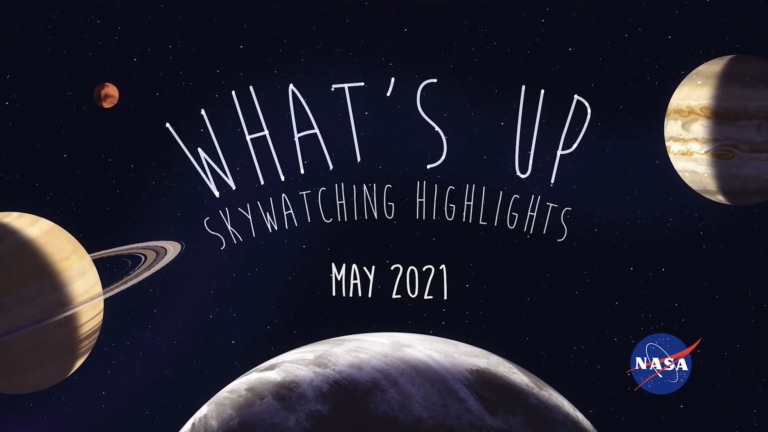
影像来源:NASA/JPL-Caltech 从5月中旬开始,如果你能找到一个朝向西方地平线的清晰视野,你将有机会在同一时间亲眼看到我们太阳系的所有四颗岩质内行星。 从5月中旬开始,在日落之后看到所有四颗内行星(包括地球!)。 影像来源:NASA/JPL-Caltech 大约从5月14日开始,在当地时间日落后约半小时,将你的目光投向西方,看看你是否能发现水星、金星和火星。(当然,地球也很难错过)。 要看清地平线附近的景象,你需要一个没有附近树木和建筑物的无遮挡的视野。最好的地方是湖岸、海滩,开阔的平原、高山或高楼。 除了行星之外,从14日左右到17日,新月也会加入这个可爱的行星场景的行列。金星在天空中的高度会非常低。但现在,请利用这个机会,在一个视野中观测所有的内行星。 月食期间,月球的颜色通常呈现出红色,因为阳光经过地球大气层的过滤。 资料来源:NASA’s Scientific Visualization Studio 5月26日带来了一次月全食。在几个小时内,月球将穿过地球的阴影,使其变暗,通常呈淡红色。红色来自穿过地球大气层的阳光——是当时发生在我们星球上的所有日出和日落所产生的光环。 由于颜色偏红,月食通常被称为 “血月”。它看起来会有多红很难预测,但大气中的尘埃会对其产生影响。(请记住,最近有几次著名的火山爆发。) 月食发生在满月的时候,而这次满月发生时,月球也接近其轨道上离地球最近的点,通常被称为 “超级月亮”。 与月食不同的是,你永远不应该看日食,用眼睛观看月食是安全的。而且,与月食不同的是,日食的观测路径往往比较狭窄,月食至少在地球夜面的任何地方都可以看到部分内容。 这张地图显示了2021年5月的月食的全球能见度。 影像来源:NASA/JPL-Caltech 现在,无论你在地球上的什么地方,月食都是在同一时刻发生的,但是在月食期间你的时钟读数当然取决于你的时区。这次日食的最佳观赏地点是环太平洋地区——也就是美洲西部、澳大利亚和新西兰以及亚洲东部。对于美国来说,夏威夷、阿拉斯加和西部各州将是最佳观赏地点。 2021年5月的月食最佳观测地点是夏威夷、阿拉斯加和美国西部各州。 影像来源:NASA/JPL-Caltech 对于美国东部地区,月食在黎明黄昏时分开始。当月球刚刚开始变暗时,你可能会观察到月食的第一部分,但当地球的阴影开始覆盖月球时,月球将接近或在地平线上。 你所在的位置越靠西,在当天早上月球落下之前,你就能看到更多的月食。在该国西半部的人将能够看到几乎整个日食。 因此,如果你在这次日食的路径上,请查看你当地的时间,了解你附近的最佳观赏时间。如果你在美国,如果你想看到这个罕见的天体事件:超级血月食,请准备早起。 以下是5月份的月相。 影像来源:NASA/JPL-Caltech 参考来源: https://solarsystem.nasa.gov/whats-up-skywatching-tips-from-nasa/
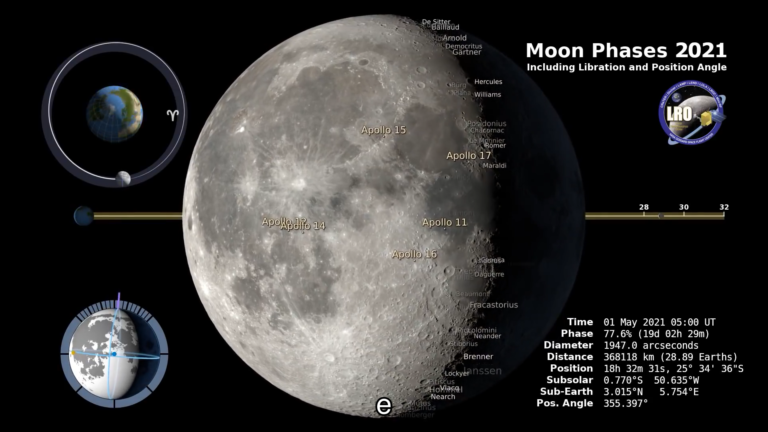
2021年01月11日 Moon Phases in 2021 Video Credit: Data: Lunar Reconnaissance Orbiter ; Animation: NASA’s Scientific Visualization Studio; Music: Brandenburg Concerto No4-1 BWV1049 (Johann Sebastian Bach), by Kevin MacLeod via Incompetech Explanation: What will the Moon phase be on your birthday this year? It is hard to predict because the Moon’s appearance changes nightly. As the Moon orbits the Earth, the half illuminated by the Sun first becomes increasingly visible, then decreasingly visible. The featured video animates images taken by NASA’s Moon-orbiting Lunar Reconnaissance Orbiter to show all 12 lunations that appear this year, 2021. A single lunation describes one full cycle of our Moon, including all of its phases. A full lunation takes about 29.5 days, just under a month (moon-th). As each lunation progresses,…
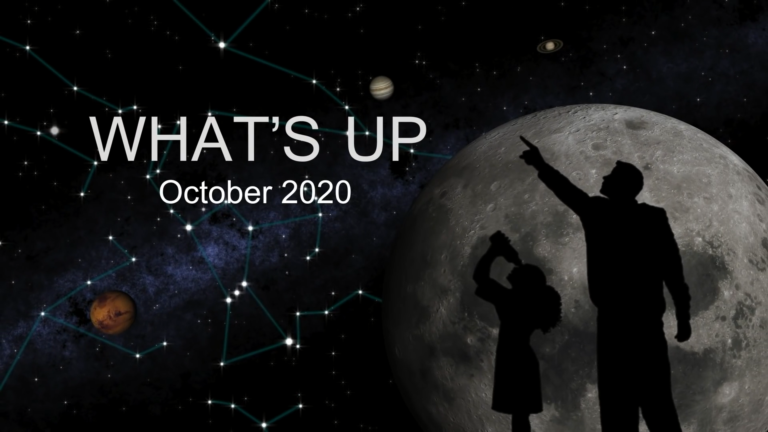
十月会发生什么?,一轮秋月以及蓝月,火星通宵达旦和一场穿越银河系的旅行。 Credit:NASA JPL 翻译:莫辞莫问的莫、林子杰 不仅一个,在月初和月未,这个月将带来两个圆满月。十月一日的满月被称作收获月,收获月是满月的名字,它最接近九月春分。每年两天中的一天,白天和黑夜长度相等。大多数年的收获月在九月落下,但每隔几年,它就会转移到10月。这个名字可以追溯到美洲原住民和欧洲传统,与收获时间有关。 Credit:NASA JPL Credit:NASA JPL 十月底,三十一号,我们将享受第二次满月。当一个月内有两次满月时,第二个满月往往被称作蓝月,蓝月还有另外一个更为传统的定义,但这是最为人熟知的。请注意这是2020年仅有的两次满月。 Credit:NASA JPL 十月是观察火星的好时机,因为这颗行星现在一整晚都可以看到,而且会在午夜时分达到它的最高点,这段能见度极好的时期与被称为“对立”的事件相吻合,约每两年发生一次,当时火星正处于地球与太阳的相对侧,这也是火星和地球在轨道上最接近的时候,这意味着这颗红色行星在天空中是最亮的,所以不要错过它。 Credit:NASA JPL Credit:NASA JPL 来自几个国家的航天器目前正在前往火星的途中,包括美国宇航局的火星2020任务,预计在二月份降落在那里。最后,这个月,是尝试和发现仙女座星系的好时机,仙女座星系也被称为M31,是一个外观与我们银河系接近但大点的螺旋星系,二者都包含干亿颗恒星,但我们认为有万亿颗行星,现在我们看不到银河系的整体形状,因为我们在其中。如果你能从远处看到它,仙女座会让我们了解了我们的星系会是什么样子。 Credit:NASA JPL Credit:NASA JPL 仙女座很微弱,最好用望远镜观察。但是即使在光污染的地区,您也可以使用双筒望远镜甚至是装有好相机的手机进行观察,在非常黑暗的天空下,它几乎肉眼可见,虽然这可能有点挑战性,但亲眼看到整个银河系是值得的。 Credit:NASA JPL 为了寻找仙女座星系,我们需要等天黑后,望向夜空中的东北方向,找到代表女王仙后座的侧面的“ W”,仙后座的右边是仙女座,包括这一串明亮的恒星。向上看,在第二颗明亮的星星的左边,当你回头扫视仙后座时,你会发现一片微弱且模糊的光斑,那块模糊的地方就是位于200万光年之外的仙女座星系。如果你成功了,恭喜!你刚刚进行了一场星际漫游。 Credit:NASA JPL Credit:NASA JPL 这是十月的月相。 Credit:NASA JPL 你可以在nasa.gov了解美国宇航局探索太阳系及更远的所有任务,我是来自美国宇航局喷气推进实验室的普雷斯顿·戴奇斯,这就是这个月的情况。 来源: https://www.jpl.nasa.gov/video/details.php?id=1635
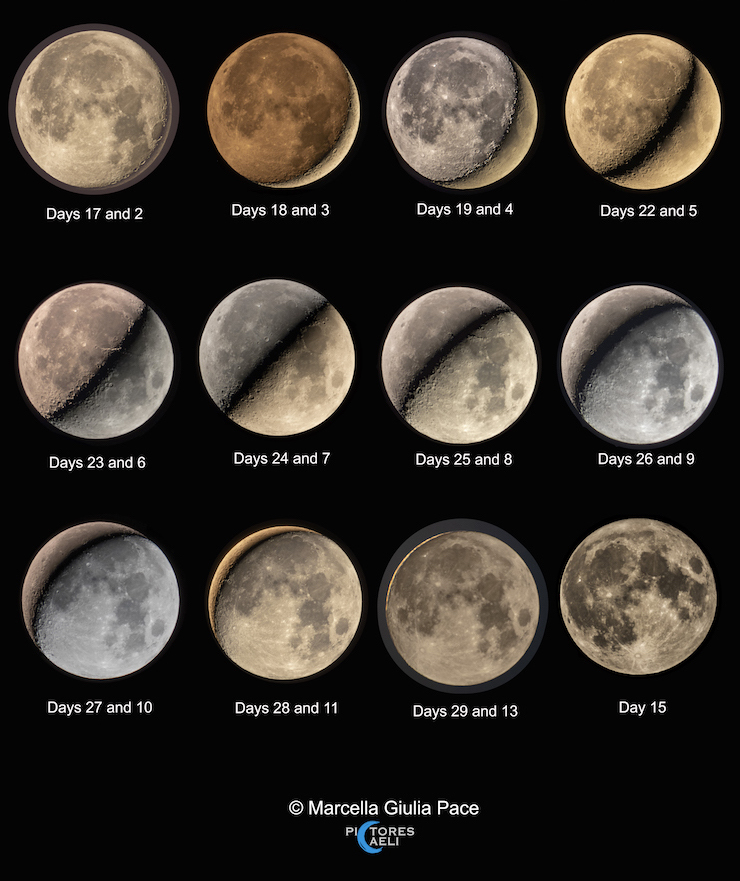
2020年9月26日 Moon Pairs and the Synodic Month Image Credit & Copyright: Marcella Giulia Pace Explanation: Observe the Moon each night and its visible sunlit portion will gradually change. In phases progressing from New Moon to Full Moon to New Moon again, a lunar cycle or synodic month is completed in about 29.5 days. They look full, but top left to bottom right these panels do show the range of lunar phases for a complete synodic month during August 2019 from Ragusa, Sicily, Italy, planet Earth. For this lunar cycle project the panels organize images of the lunar phases in pairs. Each individual image is paired with another image separated by about 15 days, or approximately half a synodic month. As a result the opposite sunlit…
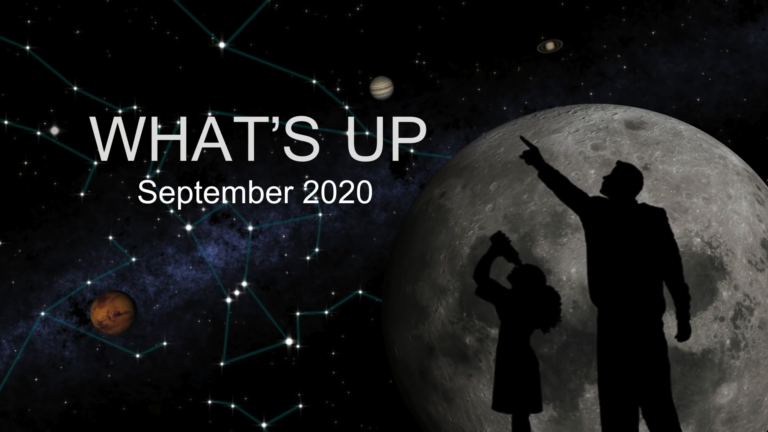
九月会发生什么?月亮与火星和金星,还有一颗失去行星的恒星。 Credit:NASA JPL 翻译:林子杰 9月6日,黎明前的天空中,你会发现月亮紧挨着火星。到了8月9日,他们将更加接近。但这仍然是本月的一大奇观。如果早起,可以出门看看,它们只会相隔几度。如果你用双筒望远镜看,它们会出现在同一个视野中。 Credit:NASA JPL 9月13日和14日,黎明前向东看,可以看到纤细的新月掠过灿烂的金星。在13日,你会发现月亮悬挂在金星上方,约有20%的表面被照亮。到第二天早上,月亮已经移到金星的左边,只有大约10%的阳光照射面可见。 Credit:NASA JPL 九月向南看,对于我们这些住在城市附近的人来说,只有一颗星星比较亮,那颗星叫做北落师门,它有一个非常有趣的故事。这颗恒星距离我们大约25光年,意味着它离这里相对较近,它也相当年轻,只有几亿年,它仍然被圆盘状的碎片包围着,这是恒星在行星形成阶段的共同特征。现在我们已经发现了数千颗系外行星——太阳系外的行星,但是北落师门似乎是第一颗通过望远镜(即哈勃太空望远镜)直接成像探测到行星的恒星。天文学家早在2008年就宣布了这一发现。 Credit:NASA JPL 原来北落师门有一颗行星!但这就是有趣的地方,由于这颗行星的轨道很古怪,没有像年轻的行星那样释放出多余的热量,在接下来的几年里逐渐衰弱,到2014年消失。2020年4月,另一组天文学家利用哈勃望远镜宣布,他们发现北落师门的“行星”根本不是行星,事实上,他们的研究表明,哈勃探测到的很可能是两个由尘埃和冰组成的小天体的巨大碰撞所产生的巨大的、不断膨胀的碎片云,与柯伊伯带的行星类似。 Credit:NASA JPL 科学家们计算出,像这样的碰撞仅每二十万年就发生在北落师门周围。所以哈勃只是碰巧在正确的时间观察到了碰撞发生后不久的景象。 Credit:NASA JPL 因此,我们可能失去了一颗行星,但对行星系统的形成和演化有了深刻的认识。日落后几个小时,你可以在南方明亮的土星和木星对的左边找到北落师门。因为它又亮又低,所以它有时会因为大气湍流而闪烁,这可能会让一些天空观察者想知道到底是什么,现在你知道了,这是北落师门。在它出现的附近恒星上,我们目睹了一次剧烈的行星碰撞。 Credit:NASA JPL 这是九月的月相。 你可以在nasa.gov了解美国宇航局探索太阳系及更远的所有任务,我是来自美国宇航局喷气推进实验室的普雷斯顿·戴奇斯,这就是这个月的情况。 来源: https://www.jpl.nasa.gov/video/details.php?id=1634